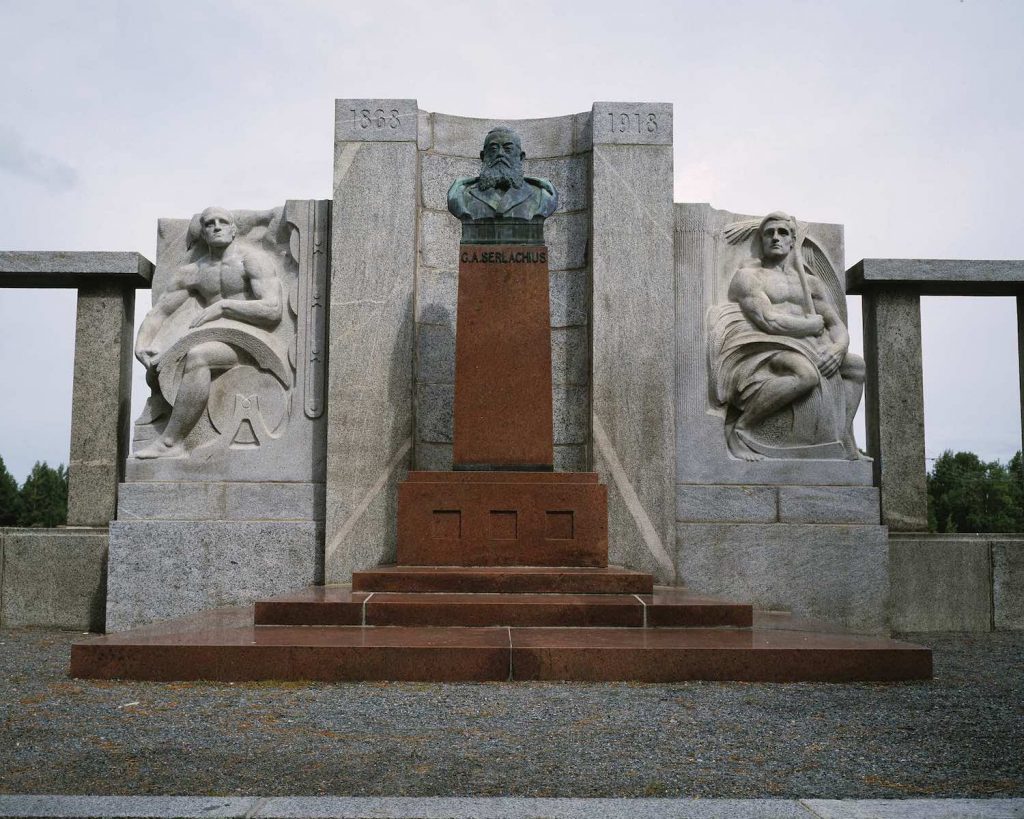G. A. Serlachius Monument
OCTOBER 2021
A monument commemorating G. A. Serlachius (1830–1901) the founder of the Mänttä mills, was unveiled hundred years ago. It was erected in accordance with garden architect Bengt Schalin’s landscape plan, on the mill side close to Mänttä castle which Serlachius had built as his home.
The monument was supposed to be completed in 1918 to celebrate the 50th anniversary of G. A. Serlachius Ltd but due to uncertain conditions it was unveiled as late as 1921. It was transferred opposite the mill in 1957 because of the enlargement of the mill. It faces the oldest parts of the ground wood mill and paper mill. The monument was acquired of M-Real Ltd for Gösta Serlachius Fine Arts Foundation in 2001. At the same time, also the surrounding green area, the so-called Patruunan puisto Park, was bought.
The width of the grey granite circle of the monument is about 20 metres and height over four metres. The stairs lead to the mill founder G. A. Serlachius’ portrait bust which is in the middle. Bronze bust made by sculptor Emil Wikström has been signed in 1918.
The portrait bust positioned on the red granite base rises higher than the symbolical reliefs on its either side. The embossed images Factory work and Agriculture which also have been created by Emil Wikström represent Mänttä’s industries. In the beginning of his career Wikström had benefitted from the support of G. A. Serlachius and managed to dominate the early-20th-century public sculpting in Finland. He was regarded as the best possible auteur.
The ideal male character in Factory work sits on a paper machine roller holding sheets of paper in his arms. In the relief representing Agriculture, the character sits at the edge of a field of rye carrying a sheaf of rye and a scythe. They represent the same kind of unsophisticated charm as the Torch Carriers that Wikström created for Helsinki railway station. Gösta Serlachius was not satisfied with Wikström’s proposal for the emblems of the industrial character. He found them as incorrect in nature and ask Eric O. W. Ehrström to make a sketch of the dry end of Mänttä’s largest paper machine. “You may possibly use the sketch attached”, he wrote to Wikström.
Architect W. G. Palmquist who did the technical drawings also participated in designing the monument. The stonework was carried out by the Hämeenlinna company Heinäsen Kiviveistämö. Heinänen send Serlachius a specimen of Eräjärvi light grey granite, but also Mänttä’s granite was considered possible as material.
“You may be surprised to hear that G. A. S. monument has today been completed. Last night the portrait bust had emerged on this place and everything looks perfect. Due to the hard times and generally known circumstances, the management (of the mill) decided to do the unveiling without any celebration. Instead, we might organize a small party when our chronicle is completed and dealt out to the friends and workers. I hope you will be present then.” This is how Gösta wrote to Wikström in January 1921.
Memorial publication of G. A. Serlachius Ltd written by P.H. Norrmén by the name “Mänttä mills” 1868–1928 was published as late as 1928. Oscar Rosenquist, the author of the publication which was intended for the celebrations of the 50th anniversary, was murdered in 1918, so that the task and celebrations were transferred to the 60th anniversary.
Helena Hänninen
Curator



